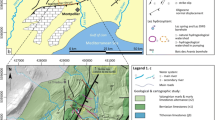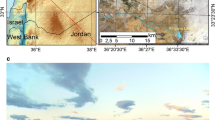Abstract
Geological structures, specifically faults, may influence the permeability of geological units and so can be an important factor in the movement of groundwater and hydrogeological processes. This study is an investigation of the local influence of the North Tabriz Fault on the hydrogeology of the adjacent unconfined alluvial aquifer. The study area is located northwest of the city of Tabriz, Iran, on the North Tabriz fault zone. The North Tabriz Fault is a prominent tectonic structure with strike-slip right-lateral kinematics and is considered as one of the most active faults in Iran. This study shows that the fault has a major influence on the hydrogeological characteristics of the local aquifers. Sharp changes in the position of aquifer bedrock and aquifer thickness over relatively short distances (<200 m) suggest a near-vertical dip for the fault evidencing its reverse movement. The fault displacement has reduced the saturated aquifer thickness in the northern sector because the northern block (hanging wall) is thrust over the southern block (foot wall). As a result of barrier behavior prohibiting flow across it, the fault has channelized groundwater roughly parallel to its strike. Sharp changes of EC and chloride values over short distances across the fault show that there is no significant leakage or groundwater mixing across the barrier. A Chadha diagram indicates a Ca–Mg–Cl water type for the majority of northern water samples and Ca–Mg–HCO3 type for all southern samples, without any transitional modes. From Gibbs plots, rock type determines the groundwater hydrochemistry. Abundant Ca + Mg in all of the southern water samples are interpreted as related to carbonate weathering and dissolution, increasing SO4 more rapidly than Cl there. Gypsiferous marl and sandstone are prominent throughout the study area, especially in the southern part, and thus can be the sources of excess SO4. As a result of this study, subsurface structural evidences such as hydraulic head patterns, flow path variations and changes in groundwater hydrochemical properties across the fault are useful tools to understand the influence of fault zones on aquifer characteristics and the hydrogeological behavior of these zones.












Similar content being viewed by others
References
Aghanabati A (2004) Geology of Iran. Geological Survey of Iran publication, 586 p. (in Persian)
Anderson E, Bakker M (2008) Groundwater flow through anisotropic fault zones in multi-aquifer systems. Water Resour Res 44:W11433
Antonellini MA, Aydin A (1994) Effect of faulting on fluid flow in porous sandstones: petrophysical properties. Am Assoc Pet Geol Bull 74(3):355–377
Balsamo F, Storti F (2011) Size-dependent comminution, tectonic mixing, and sealing behavior of a “structurally oversimplified” fault zone in poorly lithified sands: evidence for a coseismic rupture? Geol Soc Am Bull 123(3/4):601–619
Bense VF, Person M (2006) Faults as conduit–barrier systems to fluid flow in siliciclastic sedimentary aquifers. Water Resour Res. doi:10.1029/2005WR004480
Bense VF, Van Balen RT (2004) The effect of fault relay and clay smearing on groundwater flow patterns in the Lower Rhine Embayment. Basin Res 16:397–411
Bense V, Person M, Chaudhary K, You Y, Cremer N, Simon S (2008) Thermal anomalies indicate preferential flow along faults in an unconsolidated sedimentary aquifers. Geophys Res Lett 35:L24406
Bense VF, Gleeson T, Loveless SE, Bour O, Scibek J (2013) Fault zone hydrogeology. Earth-Sci Rev 127:171–192
Berberian M, Arshadi S (1976) On the evidence of the youngest activity of the North Tabriz Fault and the seismicity of Tabriz city. Geol Surv Iran Rep 39:397–418
Berberian M, King GC (1981) Towards a paleogeography and tectonic evolution of Iran. Can J Earth Sci 18:210–265
Bethke CM, Johnson TM (2008) Groundwater age and groundwater age dating. Annu Rev Earth Planet Sci 36:121–152
Burbey T (2008) The influence of geologic structures on deformation due to ground water withdrawal. Ground Water 46(2):202–211
Caine J, Forster C (1999) Fault zone architecture and fluid flow: insights from field data and numerical modeling. In: Haneberg W, Mozley P, Moore J, Goodwin L (eds) Faults and subsurface fluid flow in the shallow crust. Geophysical Monograph 113. American Geophysical Union, pp 101–127
Caine JS, Minor SA (2009) Structural and geochemical characteristics of faulted sediments and inferences on the role of water in deformation, Rio Grande Rift. GSA Bull, New Mexico
Caine JS, Evans JP, Forster CB (1996) Fault zone architecture and permeability structure. Geology 24(11):1025–1028
Chadha DK (1999) A proposed new diagram for geochemical classification of natural water and interpretation of chemical data. Hydrogeol J 7:431–439
Djamour Y, Vernant P, Nankali HR, Tavakoli F (2011) NW Iran-eastern Turkey present-day kinematics: results from the Iranian permanent GPS network. Earth Planet Sci Lett 307:27–34
Emberger L (1955) Une classification biogeography que des climats. Rev Trav LabBot Fac Sci 7:3–43
Evans JP, Forster CB, Goddard JV (1997) Permeability of fault-related rocks, and implications for hydraulic structure of fault zones. J Struct Geol 19:1393–1404
Fisher QJ, Knipe RJ (2001) The permeability of faults within siliciclastic petroleum reservoirs of the North Sea and Norwegian Continental Shelf. Mar Pet Geol 18(10):1063–1081
Folch A, Mas-Pla J (2008) Hydrogeological interactions between fault zones and alluvial aquifers in regional flow systems. HydrolProcess 22:3476–3487
Forster CB, Evans JP (1991) Hydrogeology of thrust faults and crystalline thrust sheets: results of combined field and modeling studies. Geophys Res Lett 18(5):979–982
Geraud Y, Diraison M, Orellana N (2006) Fault zone geometry of a mature active normal fault: a potential high permeability channel (Pirgaki fault, Corinth rift, Greece). Tectonophysics 246:61–76
Gibbs RJ (1970) Mechanisms controlling world water chemistry. Science 17:1088–1090
Goldscheider N, Drew D (2007) Methods in karst hydrogeology. Taylor & Francis, International contributrions to hydrogeology, p 279
Hesami K, Pantosi D, Tabassi H, Shabanian E, Abbassi MR, Feghhi K, Sholaymani S (2003) Paleoearthquakes and slip rates of the North Tabriz Fault, NWIran: preliminary results. Ann Geophys 46:903–915
Jackson J (1992) Partitioning of strike-slip and convergent motion between Eurasia and Arabia in Eastern Turkey and the Caucasus. J Geophys Res 97(12):471–479
Karakhanian AS, Trifonov VG, Philip H, Avagyan A, Hessami K, Jamali F, Bayraktutan MS, Bagdassarian H, Arakelian S, Davtian V (2004) Active faulting and natural hazards in Armenia. East Turk North-Western Iran, Tectonophys 380(3–4):189–219
Leray S, de Dreuzy JR, Bour O, Labasque T, Aquilina L (2012) Contribution of age data to the characterization of complex aquifers. J Hydrol 464–465:54–68
Mayer A, May W, Lukkarila C, Diehl J (2007) Estimation of fault-zone conductance by calibration of a regional groundwater flow model: desert Hot Springs, California. Hydrogeol J 15:1093–1106
McKenzie DP (1972) Active tectonics of the Mediterranean region. Geophys J Int 30:109–185
Moradi AS, Hatzfeld D, Tatar M (2011) Microseismicity and seismotectonics of the North Tabriz fault (Iran). Tectonophysics. doi:10.1016/j.tecto.2011.04.008
Nabavi MH (1976) An introduction to the geology of Iran. Geol Surv Iran, 109 p. (in Persian)
Rawling G, Goodwin L (2006) Structural record of the mechanical evolution of mixed zones in faulted poorly lithified sediments, Rio Grande rift, New Mexico, USA. J Struct Geol 28:1623–1639
Sengor AMC, Tuysuz O, Imren C, Saking M, Eyidogan H, Gorur N, Le Pichon X, Rangin C (2005) The North Anatolian Fault: a new look. Earth-Sci Rev. doi:10.1146/annurev.earth.32.101802.120415
Sigda JM, Goodwin LB, Mozley PS, Wilson J (1999) Permeability alteration in small displacement faults in poorly lithified sediments: Rio Grande Rift, central New Mexico. In: Haneberg WC, Mozley PS, Casey Moore J, Goodwin LB (eds) Faults and subsurface fluid flow in the shallow crust, vol 113. American Geophysical Union, pp 51–68
Stocklin J (1977) Structural correlation of alpine ranges between Iran and Central Asia. Memorie Hors Serie No.8de la SocGeolo. de France 8:333–353
Taghipour K, Mohajjel M (2014) Structure and formation of travertine deposits in the northwest of Iran. Q J Geol Iran 25:15–33 (in persian)
Vafaei J, Taghikhany T, Tehranizadeh M (2011) Near field effect on horizontal equal-hazard spectrum of Tabriz city in north-west of Iran. Int J Civ Eng 9:49–56
Yielding G, Freeman B, Needham DT (1997) Quantitative fault seal prediction. Am Assoc Pet Geol Bull 81(6):897–917
Zhang Y, Schaubs P, Zhao C, Ord A, Hobbs B, Barnicoat A (2008) Fault-related dilation, permeability enhancement, fluid flow and mineral precipitation patterns: numerical models. The Internal Structure of Fault Zones: implications for Mechanical and Fluid-flow Properties. The Geological Society of London 299:239–255
Acknowledgments
The authors are grateful to Sian Loveless from the Flemish Institute of Technological Research and Derek C. Ford from the McMaster University for reading and correcting the draft of this document and providing important suggestions. The authors also thank Fabrizio Balsamo from Parma University for his valuable comments and the University of Tabriz, Iran, for additional support.
Author information
Authors and Affiliations
Corresponding author
Rights and permissions
About this article
Cite this article
Rajabpour, H., Vaezihir, A. & Sedghi, M.H. The North Tabriz Fault, a barrier to groundwater flow in an alluvial aquifer northwest of Tabriz, Iran. Environ Earth Sci 75, 849 (2016). https://doi.org/10.1007/s12665-016-5663-9
Received:
Accepted:
Published:
DOI: https://doi.org/10.1007/s12665-016-5663-9




